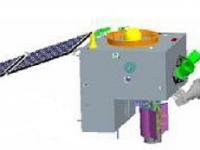SJ-9 (Shi Jian = Practice) is a technology demonstration formation flight mission of CNSA (China National Space Administration), consisting of two minisatellites of different sizes and capabilities, SJ-9A and SJ-9B. The overall mission concept is to demonstrate the functionality of a range of newly developed formation flying techniques and components and to validate the formation flight GNC (Guidance, Navigation and Control) algorithms and strategies of the system configuration.
SJ 9B carries the LWIR (Long Wave Infrared) Camera as a technology experiment. The goal of the LWIR camera is to test mainly the functions of the instrument such as the focal-plane component and the long-life Stirling cryocooler which is designed to function as an autonomic research and development component. The camera features low-temperature optics. The operational temperature of optical system is kept in the range of -35ºC to -20ºC.
Instrument: LWIR (Long Wave Infrared) Camera
